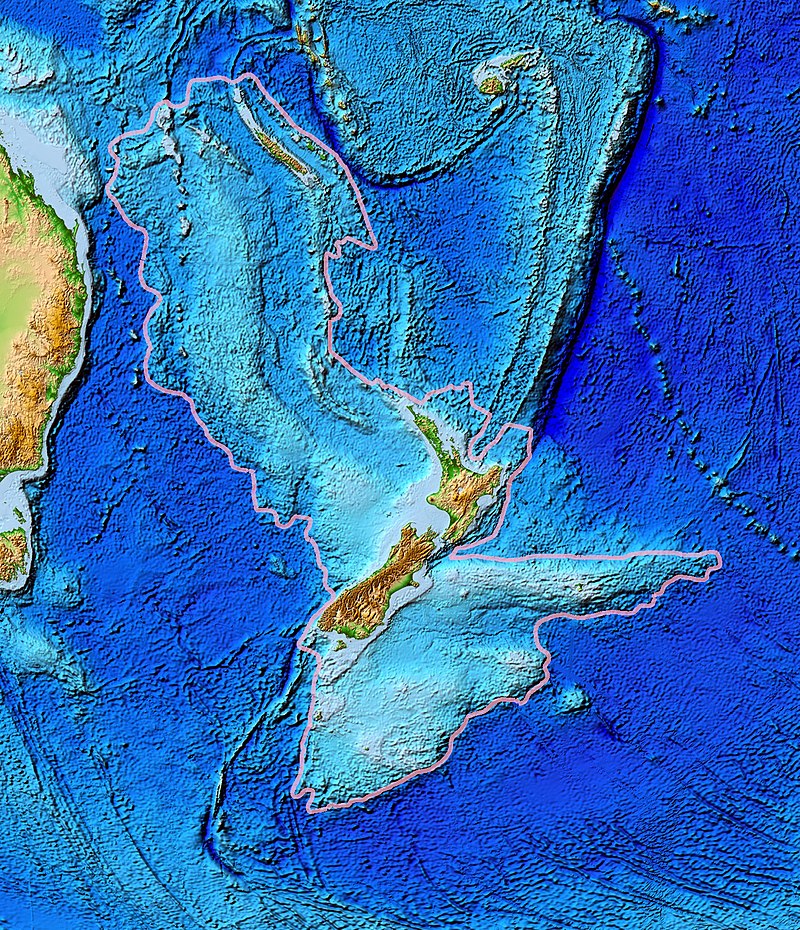NASA space data supports citizens' observations: Meteor fireballs are increasing dramatically
Dr. M.A. Rose
Sott.net
Sat, 09 Jan 2016 20:05 UTC
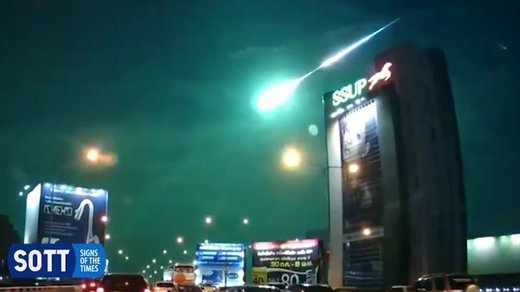
SOTT.net last looked in detail at the frequency of meteor fireballs in 2013, using the data garnered by the American Meteor Society (AMS). SOTT.net pointed out the increasing frequency of fireballs1, and asked the question: "
What does 2014 have in store?"
Well, the results are in, and the answer is simple: comparing 2014 to 2013, the frequency of fireballs increased by 120%.
Comparing 2015 to 2014, fireballs increased by 20%. That is a significant increase, and it should be generating a lot of attention. If it is, then it's being done very quietly behind closed doors.
Since October 2013, the web site
spaceweather.com has published daily data from NASA's All-Sky Fireball Network, which observes, and daily reports, fireball activity over the US.2
I have collated both sets of data - from NASA and the AMS - to produce the following graphs, taking into account that each dataset relies on different definitions of 'meteor fireball'. Click on the graphs to view them at full size.
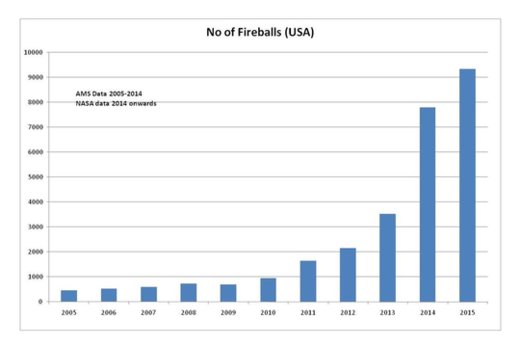
© Dr M.A. Rose
Overall increase in meteor fireballs over the US in the last decade
Because we are using two datasets, there can be some incongruity for the 2013-2014 data.
Nevertheless, the pattern is congruent: from 2010 onwards, the frequency of fireballs has been increasing each year in an exponential fashion (until 2015, when the rate of increase slowed down). Such a change is significant and should be generating
a lot of media attention and
a lot of activity in near space observation.
The most significant way to plot the data is via a 12-month rolling average, which smooths out 'noise' and demonstrates any significant changes that have occurred.
From mid-2010, the average number of fireballs significantly increased, until late 2015 when the rolling average stabilised.
Collating the data into a 6-month rolling average reveals the asymmetric distribution across the year.
Fireballs are occurring at higher numbers in the latter part of the year. This difference in distribution significantly increased after 2013. That is, one part of space is becoming dense with dust and rocks, and Earth (and other planets in the inner solar system) are moving through this area of space every year.
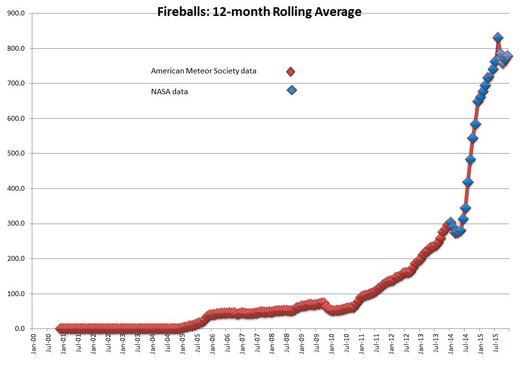
© Dr M.A. Rose
12-month rolling average of meteor fireballs over the US in the last decade
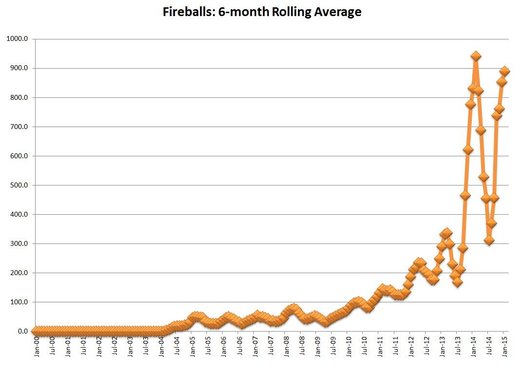
© Dr. M.A. Rose
6-month rolling average of meteor fireballs over the US in the last decade
Looking at NASA's data month by month, we see that the fireball frequency is most concentrated in the months August to December. However, the numbers for June and July are also increasing significantly,
suggesting that the area of space from which asteroid and comet debris is reaching Earth (or, alternatively, into which the solar system is moving),
is increasing in size:
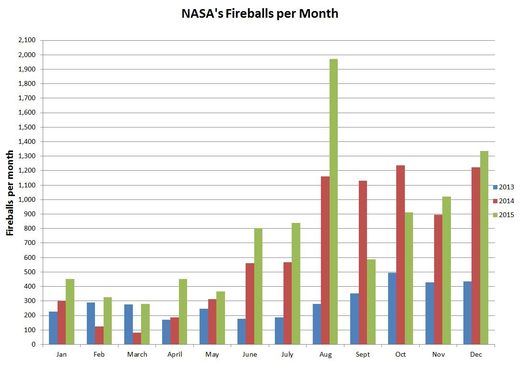
© Dr. M.A. Rose
NASA-observed fireballs, broken down by month, 2013-2015
Where there is meteor smoke, there are asteroids
NASA has also published data for near-Earth asteroids (NEAs, or near-Earth objects, NEOs) discoveries since 1995.3 Their data shows
a consistent increase in asteroid numbers from 1998-2013, and significant increases for 2014 and 2015
, which shadows the big increases in fireballs observed over those two years.
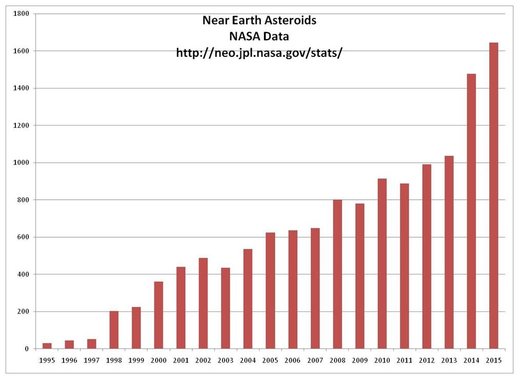
© Dr M.A. Rose
Increase in Near Earth Asteroids in last two decades
Another remarkable change is
the increase, since 2000, in the outer planets' new moons/satellites.4 Jupiter and Saturn appear to have effectively shielded the planets in the inner solar system by trapping the larger 'rocks' in their gravitational fields, in the process gaining new moons:
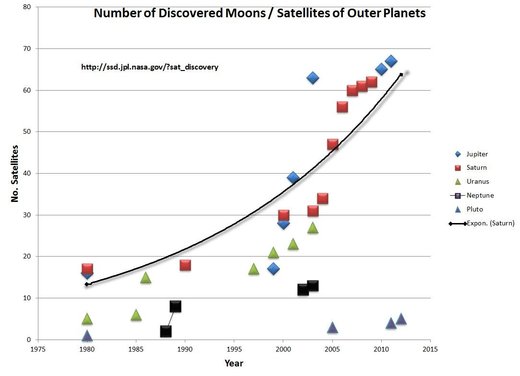
© Dr. M.A. Rose
Increase in the number of satellites acquired by the outer planets of the solar system
This might be related to the decline, since 2000, in new discoveries of large NEAs (rocks greater than 1km in diameter):
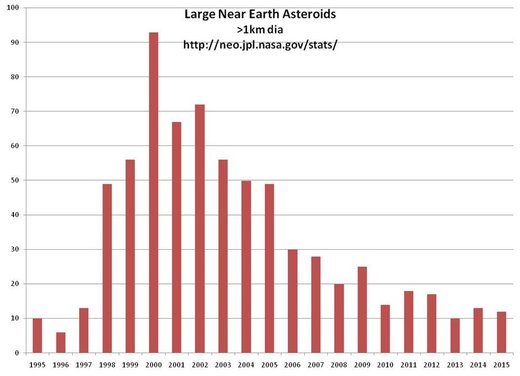
© Dr. M.A. Rose
To summarize, here's what we can deduce from these datasets:
- The number of fireballs being observed has slowly increased over the years 2000-2011. Thereafter, their numbers increased rapidly, and moreover, the very rapid increase came from a specific area of space. Most occurred during the period August to December. 2014 and 2015 saw major increases in fireball numbers
- NEA numbers have been observed since 1995. From 1998-2013 the number of new NEAs discovered has relentlessly increased, with major increases in 2014 and 2015. The pattern matches that of the recorded fireballs
- The number of discoveries of large NEAs peaked in 2000, then declined to 2010, and plateaued out thereafter
- Saturn and Jupiter began increasing their number of moons circa 2000/2001, and the numbers stabilized around 2010
It would be interesting to plot the positions of the large outer planets relative to Earth over this time period, and determine whether the decrease in large NEAs in 2000 is connected to the increase of moons around the outer planets - that is, whether the outer planets, when in the right part of space, capture the larger rocks/asteroids.
More intense meteor showers
and more sporadics
We have a limited database from NASA, but
the following meteor showers revealed significantly increased fireball numbers for 2015 as compared with 2014:
- Perseids - from Comet 109P Swift-Tuttle
- Northern Taurids - Debris from Comet Encke. The Taurids and Encke are thought to be part of a much larger comet that disintegrated over the past 20,000-30,000 years. Planetary perturbations have split the debris stream into two observable showers (Northern & Southern).
The 2013 data only covers the latter part of the year. The following meteor showers showed
significant increasing fireball numbers for 2014 as compared with 2013, but showed no significant increase for 2015 vs 2014:
- Geminids - Unlike most meteor showers, the Geminids are not associated with a comet but with Asteroid 3200 Phaethon
- Perseids - Comet 109P Swift Tuttle
- Orionids - Debris from Comet 1P Halley
- Sigma Hydrids - Showed increasing Fireball numbers across each year
- Sigma Hydrids - Faint shower. The meteors are said to have a "Perseid-type velocity." It is assumed that the source was a long-period comet and these are the last remnants of its tail
Keep in mind, however, that
the vast majority of fireballs are classed as 'sporadics', i.e. they are not identified with any known meteor shower. They may occur during the same time period as a named meteor shower, but travel in different directions and occur in different parts of the sky.
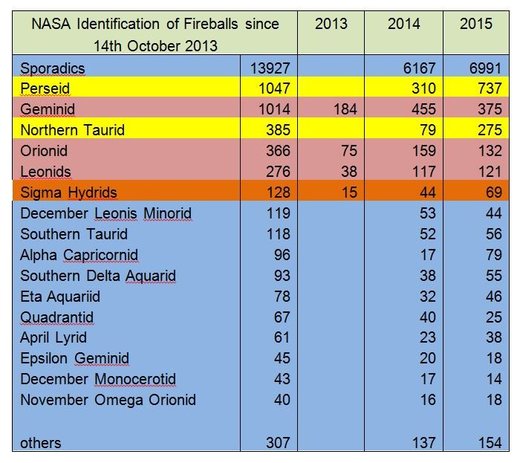
© Dr. M.A. Rose
NASA's identification of fireballs since
October 2013. Note that the vast majority of them could not be associated with known meteor streams...
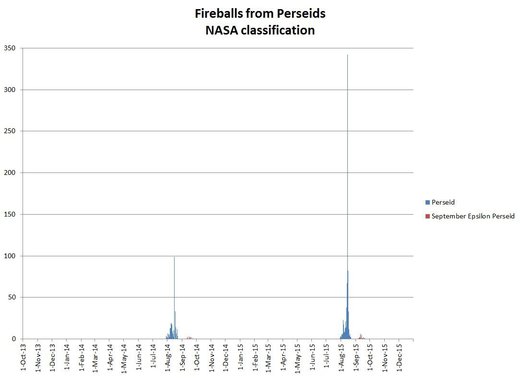
© Dr. M.A. Rose
From 2014 to 2015 NASA registered a more than 3-fold increase in fireballs identified as Perseids
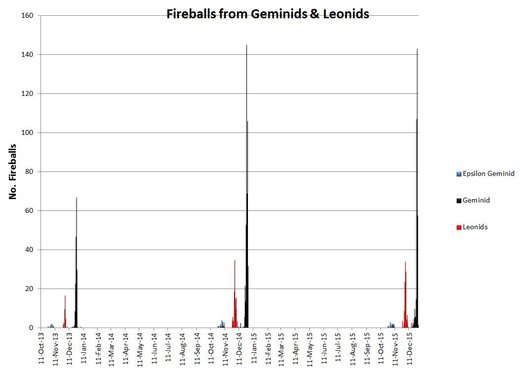
© Dr. M.A. Rose
From 2013 to 2014 NASA registered a more than 2-fold increase in fireballs identified as Geminids and Leonids
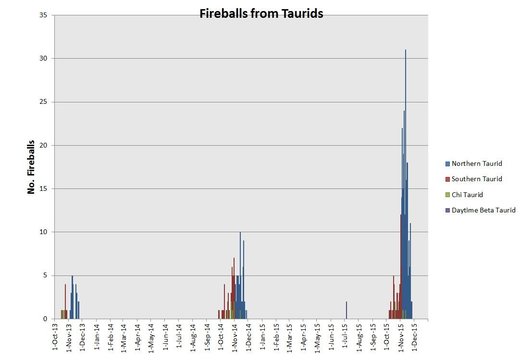
© Dr. M.A. Rose
From 2013 to 2014 NASA registered a 2-fold increase in fireballs identified as Taurids. From 2014 to 2015 there was a more then 3-fold increase
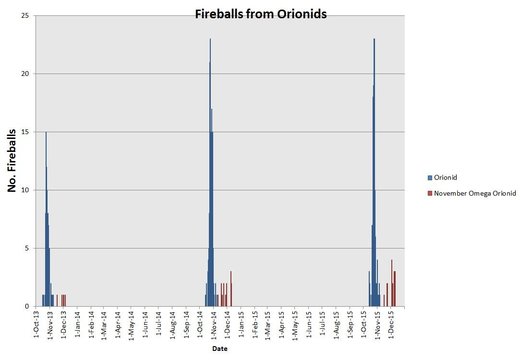
© Dr. M.A. Rose
2015 finished with about 20% more fireballs compared to 2014:
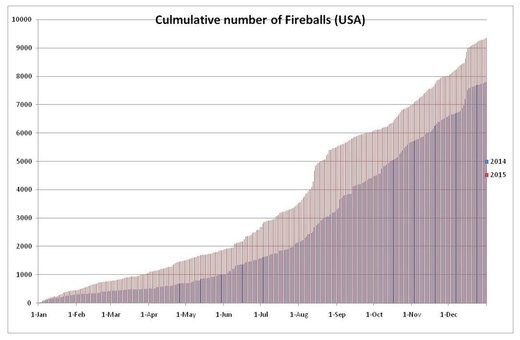
© Dr. M.A. Rose
What's up (in space)?
So it appears that one of a couple of things is happening:
- The solar system is moving into an area of space where it is encountering a higher density of rocks/asteroids, along with the debris trails of some comets, e.g. Encke
- Or something a la 'Nemesis'5 is approaching the inner solar system and perturbing comets/asteroids from the Kuiper Belt and/or the Oort Cloud.
- The two scenarios are not mutually exclusive: the first scenario could also be triggered by the second.
The 'Nemesis' hypothesis6,7 proposes that the Sun has a companion star - a brown or red dwarf - in a highly elliptical orbit that periodically disturbs comets/asteroids in the Oort Cloud, causing a large increase in the number of comets visiting the inner solar system, and a consequential increase in impact events on Earth.
No 'Nemesis' twin sun has yet been detected by NASA's WISE (Wide-field Infrared Survey Explorer) telescope - or so we're told - but WISE
has discovered several brown dwarfs in neighboring star systems.8
More recently, Napier et.al.9 published a paper highlighting the significance of Centaurs in the Oort Cloud. Centaurs are giant comets in the trans-Neptunian region, which if displaced into the main solar system, could disintegrate and lead to intermittent but prolonged bombardment of inner solar system planets, for up to 100,000 years. Their opening paragraph is worth reproducing here: Do we live in dangerous times? The risks to civilization from impacts by asteroids and comets have been appreciated only in the past few decades. Programmes such as NASA's Spaceguard observations seek to map near-Earth objects (NEOs) as a way to quantify the risk to Earth. But does the current count of NEOs reflect the population over time? We argue that the population is variable and that assessments of the extraterrestrial impact risk based solely on near-Earth asteroid counts underestimate its nature and magnitude for timescales of order 10,000 years, i.e. the interval of interest and concern to our civilization.
A more variable but significant threat comes from Centaurs, giant comets derived from the trans-Neptunian region that reach the inner solar system generally via short-term, dynamically unstable residence periods in the outer planetary region. The disintegration of such giant comets would produce intermittent but prolonged periods of bombardment lasting up to 100,000 years. Mass extinction/geological boundary events on Earth show such a pattern, as do levels of dust and meteoroids in the upper atmosphere. Over the past 10,000 years, Earth has been experiencing the intermittent arrival of dust, meteoroids and comet fragments from the disintegration of comet 2P/Encke, trapped within the orbit of Jupiter. Napier et al further noted that, "
All three major 20th-century impacts (Tunguska, British Guiana, Curuca River) coincided with our passage through major meteoroid streams (respectively, the Beta Taurids, Geminids and Perseids)." We currently have significant increases in fireballs among the Perseids and Northern Taurids.








